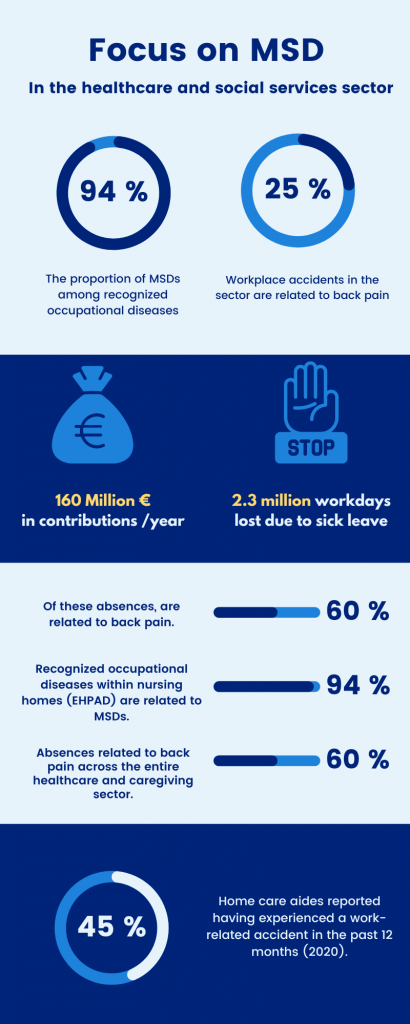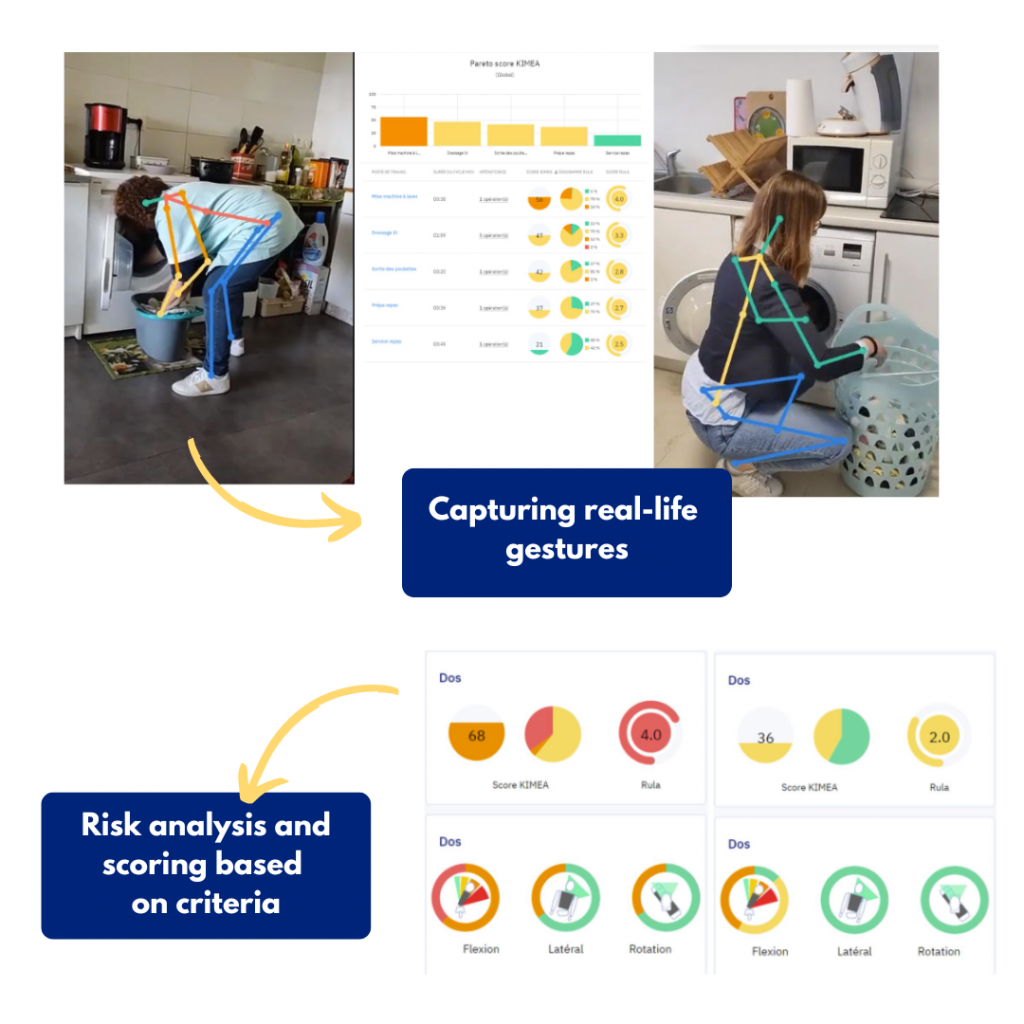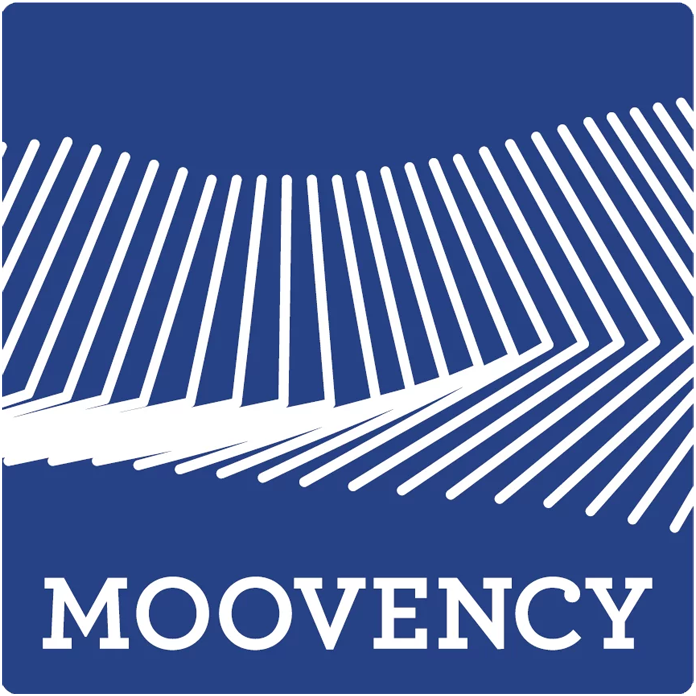Healthcare and medico-social sector : Focus on MSD prevention
The healthcare and medico-social sector, including professions such as home care, support for the elderly or disabled, and home care services, is an essential field experiencing constant growth, especially since the health crisis of 2020.
However, this expansion also comes with challenges as occupational risks increase, with one of the most concerning being the risk of Musculoskeletal Disorders (MSD) among workers in this sector. Workplace accidents and occupational diseases continue to rise, placing the sector at a significantly higher risk level than average. Consequently, sick leave durations lengthen, and the associated costs amount to millions of euros.
A question arises: how can we support professionals in the healthcare and medico-social sector in their prevention efforts?
Let’s first take a brief overview
In the healthcare and medico-social sector, the prevalence of Musculoskeletal Disorders (MSD) among recognized occupational diseases stands at 94%. Furthermore, 25% of workplace accidents in the sector are attributable to back pain. The financial impact is significant, with companies annually paying 160 million euros in contributions due to these incidents, resulting in the loss of over 2.3 million workdays due to sick leave of affected employees, of which over 60% are related to back pain.
Workers in Nursing Homes for Dependent Elderly Persons (EHPAD) are particularly affected by MSD, representing 94% of recognized occupational diseases within these establishments. This reality translates into a significant financial and economic impact, with contributions totaling 46 million euros paid due to these incidents, leading to the loss of over 660,000 workdays due to sick leave of affected employees.
Regarding home aides and personal service more generally, the most frequent accidents include falls, road accidents during patient visits, burns, and musculoskeletal disorders (MSD) related to patient handling, as well as injuries related to repetitive motions.

Approximately 45% of home aides report having been victims of a workplace accident during the year. This results in 22.6 days of sick leave for workplace accidents or occupational diseases, compared to 18.5 days across all sectors.
It is evident that we are dealing with a particularly troubled professional sector (not to mention workplace stress and/or organizational issues), which are also aggravating factors.
So, how can we assist these professionals who work in a changing work environment dependent on external factors over which they have little control ?
1 – Risk Assessment :
Risk assessment is the starting point for any prevention approach. This essential step involves identifying situations of exposure to occupational risks to identify, analyze, and classify these risks. Risk assessment helps prioritize actions within a prevention strategy. The most appropriate prevention actions can then be defined to address the specificities of the context.
Regarding MSDs, enlist an ergonomist to conduct a comprehensive analysis of your activities. This 360° approach includes all risk factors for MSDs (psychosocial, biomechanical, organizational, environmental, individual). The ergonomist can provide a clear understanding of aggravating risk factors in your team’s work. Following this analysis, the ergonomist will offer recommendations and action plans to optimize the environment and well-being of your teams.
2- Prevention, awareness, and training above all !
You might say we’re repeating ourselves, but we can’t stress enough the importance of prevention, awareness, and training in addressing risks!
Employees are the first affected, so they must be convinced and involved in the process. Implement theoretical training on what MSDs are and how they occur, practical training on professional best practices, on gestures, and postures…
Additionally, conduct on-site awareness workshops to place your employees in real work situations and leverage new technologies to provide evidence and concrete visuals through engaging and educational tools.
The key is to inform your teams about the reality of MSDs and the impact they can have so that they can act in their daily lives and with their colleagues and become prevention actors.
3- Utilize relay actors and financing opportunities!
From your regional CARSAT (Pension and Occupational Health Insurance Fund) to social security or public authorities, specific programs and financial aid dedicated to your sector exist.
Programs like MSD PROS are structured around 4 steps and based on a participatory approach to continuous improvement. Tailored to the specificities and constraints of the healthcare and medico-social sector, you will be accompanied by a prevention professional from your regional fund who ensures on-the-ground expertise.
To support the commitment and implementation of this approach, financial aid and training are available to support professionals engaging in such initiatives. Financial aids (MSD Pros diagnostics) allow you to finance 70% of the training for an internal prevention resource or officer and/or the ergonomic study of work situations to conduct a prevention diagnosis and develop an action plan.
To support the implementation of the action plan, “TMS Pros Action” finances 50% of the purchase of equipment and/or materials necessary to reduce physical constraints, especially during manual handling of loads, repetitive efforts, or restrictive postures. It also finances tailored training for the employees concerned.
Designed for healthcare and medico-social establishments with fewer than 50 employees, the Health French Insurance – Occupational Risks offers the aid. Capped at 25,000 euros, this subsidy corresponds to the investment made to acquire equipment packs or training services.
Therefore, seize these opportunities to initiate your initiatives and establish a sustainable and enduring prevention strategy for your teams.
Moovency is here to assist you
As a registered partner with CARSAT Bretagne, Moovency can support you in your MSD Pros initiative, including a comprehensive analysis of the risk of MSDs within your organization. Our team of ergonomists, all IPRP certified, operates nationwide.
Equipped with our Kimea solution, they can analyze your activities in a fun and educational manner, provide training for your teams, and assist you in implementing and monitoring your prevention actions.
With real-time visualization of the biomechanical risk of MSDs, Kimea allows you to provide your teams with visual and concrete support for a problem that may sometimes seem theoretical and distant to frontline staff. In addition, our ergonomists’ expertise, integrating all risk factors, ensures a 360° analysis of your activities, supported by recommendations and an action plan.

Sources utilisées : Ameli.fr / Carsat.fr
Read more : https://www.ameli.fr/entreprise/sante-travail/risques/troubles-musculosquelettiques-tms/demarche-tms-pros
